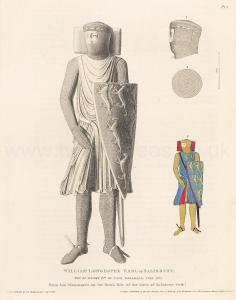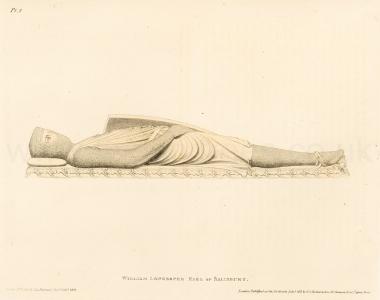Effigy of William Longespee
Effigy of William Longespee is in Monumental Effigies of Great Britain.
WILLIAM Longespee was the bastard son of Henry the Second by the celebrated Rosamund de Clifford [Note. William is now believed to be the son of Ida Tosny Countess Norfolk; a charter William made that mentions "Comitissa Ida, mater mea" (Countess Ida, my mother)]. His half-brother, Richard the First, gave him in marriage Ela, daughter and inheritrix of William Earl of Salisbury. He bore a conspicuous part in the domestic divisions in the reign of King John, whose general he was against the rebellious Barons in 1215, but in the following year went over to the party of Louis the son of the French king. On the death of John he abandoned the cause of Louis, did homage to the young King Henry the Third, and united with William Mareschal, the spirited Earl of Pembroke, then Regent, in raising the siege of Lincoln. In 1219 he was with other English noblemen at the siege of Damietta, which place was vigorously defended by the Saracens, and the capture of which cost the Christian forces very dear. In 1224 he went over into Gascony with Richard Earl of Cornwall, to subdue certain towns and castles to obedience to King Henry their Lord. Returning in the following year they were over-taken at sea by a violent tempest; after beating about for many nights and days they were carried far out of their course; and, giving themselves up for lost, committed all their treasure and rich garments to the deep. While they remained in darkness and despair, on a sudden the whole vessel was illuminated by the brilliant flame of a huge wax taper, which appeared on the prow, and by it a damsel of exceeding beauty, who protected the light with her garment from the force of the wind and rain. While the crew were lost in wonder at this miraculous nocturnal vision, the Earl of Salisbury proclaimed that their thanks were due to the Blessed Virgin for this merciful interposition, at whose shrine, on the day of his knighthood, he had offered a taper to be kept constantly burning on the daily celebration of the offices to her honour. The courage of the dispirited crew revived, and the following morning they made the Isle of Rhé, near Rochelle. Salisbury was speedily obliged to put to sea again, being informed of the design of the Lord of the place to make him prisoner. He braved the adverse elements for three months longer before he reached England. Such is the relation of Matthew Paris. His long absence gave occasion to a current report that he was lost at sea, and Hubert de Burgh, Justiciary of England, solicited to be allowed to match a kinsman of his, one Raymond, who had a claim to the Earldom of Salisbury, with his rich widow, but she, like another Penelope, rejected this suitor. At length the Earl landed unexpectedly in Cornwall, and demanded satisfaction of the King against Hubert, whose relative had assailed the honour of his wife. Hubert made submissive reparation by presents, but is reported to have taken the Earl off by poison, administered to him at a feast to which he had invited him in simulated reconciliation.




Be this as it may, he retired to his castle at Sarum [Map], grievously sick, and sent for the Bishop of the place to administer to him the Sacrament, on whose approach with the host, he leaped from his bed with a rope round his neck, as a wretched malefactor, and throwing himself on the door, exclaimed he was a traitor to Almighty God, and refused to arise until he had received absolution and the Sacrament. He died in March 1226, and was borne from the Castle to the Church, then newly erected at Salisbury [Map]. It is pretended, that, although it blew a tempest during the funeral procession, the tapers borne by the clergy in procession were not extinguished, so evident were the signs of his acceptance with Heaven. He gave, by his last will, several valuable donations to the Canons of Bradenstoke, and property to endow a Carthusian monastery. Ela surviving him, fulfilled his pious intentions, and also founded for the good of her own and her husband's soul the Abbey of Laycock [Map], of which she became Abbess, died circa 1263, and was buried in the choir of the Church there. On the alterations which took place in Salisbury Cathedral a few years since, the effigy of William Longespee was found entire. It had originally been buried in the Chapel of the Virgin, of whose patronage and favour he thought himself so eminently the object. His remains were about 1790 removed to their present situation in the nave, inclosed in a wooden tomb, on which his effigy rests. Nothing can be finer than the style in which this representation of a grandson of Geoffrey Plantagenet rests. The mails of his hauberk are of golden hue. On his blue surcoat are the lions rampant which are found on his ancestor's shield. One remarkable character of this figure, is the flaccid, lifeless air with which it reposes on the coffin lid which covered Salisbury's mortal relics.
Details. Plate I. 1. The head with the hood of the hauberk, under which is probably a cylindrical defence for the head. 3. The top of the hood. 3. The whole figure restored to its appearance as originally painted.

